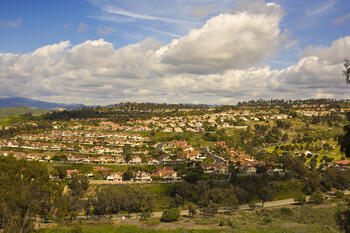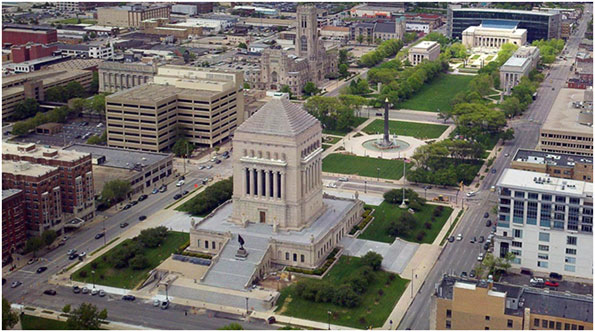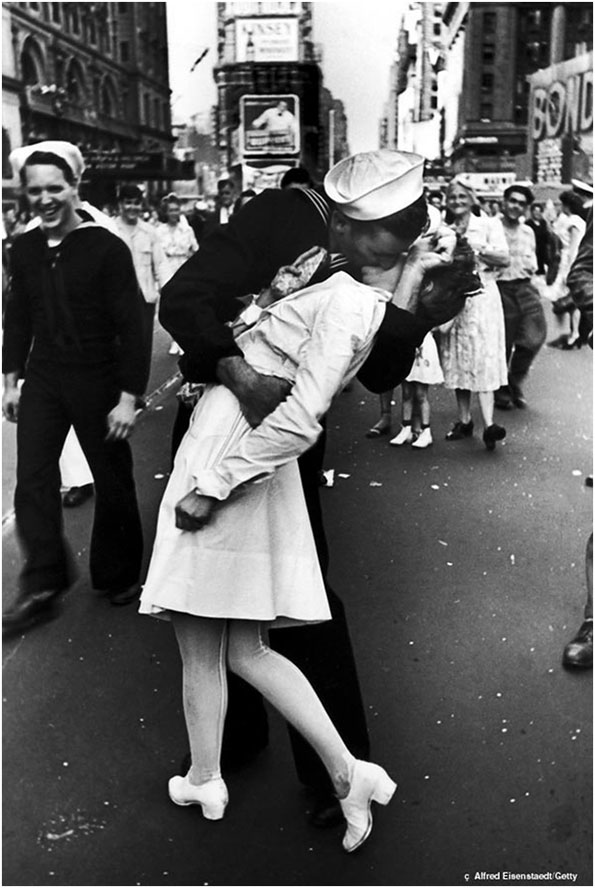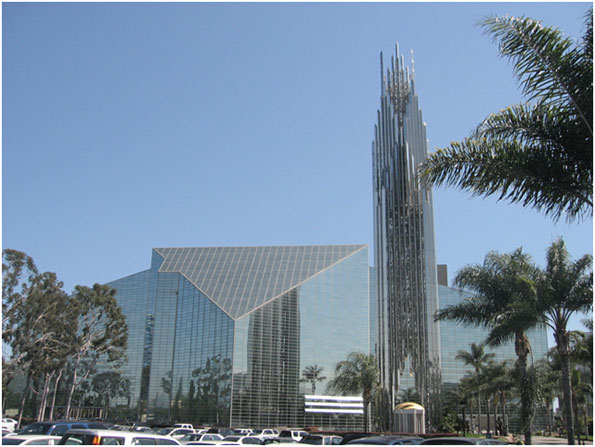
Suburbs are often unfairly maligned as lacking the qualities that make cities great. But one place that criticism can be fair is in the area of sacred space. There most certainly is sacred space in the suburbs, but usually less of it than in the city both quantitatively and qualitatively. In fact, the comparative lack of sacred space is one of the distinguishing characteristics of the suburb that makes it “sub” urban, that is, in a sense lesser than the city.
Lewis Mumford put it this way:
Behind the wall of the city life rested on a common foundation, set as deep as the universe itself: the city was nothing less than the home of a powerful god. The architectural and sculptural symbols that made this fact visible lifted the city far above the village or country town….To be a resident of the city was to have a place in man’s true home, the great cosmos itself.
Mumford was onto something here in positing how great temples and such distinguished the city as unique.
What Is Sacred Space?
Mumford also hints at what makes something truly sacred space. We should clearly distinguish between what is merely public space and truly sacred space. The key to sacred space is the linkage to the transcendent. That is, sacred space connects us to something beyond or bigger than our surroundings, our present existence, and even ourselves.
Here are three ways sacred space can do that. It can:
- Connect us to a larger spiritual or religious reality, as in our Mumford example. This is the most obvious case.
- Serve as a locus or repository of the culture and traditions of a people.
- Be a temporal connection between the present and the past and/or the future.
As one example, consider the Indiana World War Memorial in downtown Indianapolis.

This building is of course a symbol of the bedrock American values of that community and the willingness of its people to die to defend them yesterday, today, and tomorrow. Thus it is both a cultural repository and a temporal linkage.
Also note the use of neoclassicism. The use of neoclassical architecture anchors Indianapolis and Indiana firmly within the 2,500 year history of Western Civilization, as a link in a chain of peoples connected by shared, timeless values and extending backwards and forward throughout time, thus achieving a sort of immortality. This building is a statement of the permanence of this community, its people, and their values.
We can also think of a radically different space such as Times Square, and how it has played host to so many civic celebrations and traditions over the years such that it has become not just a local but a national repository of our culture. The ball dropping on New Year’s Eve is an obvious example. But consider also this iconic photo.

This is one of the most famous pictures from the war era and I don’t think it’s any surprise it was taken Times Square.
How Suburbs Are Comparatively Lacking in Sacred Space
Let’s apply the definition of sacred space to the suburbs. Yes, suburbs do have war memorials and culture and traditions and churches, but in general these are qualitatively different from what is found in the city core. Here are three reasons why.
1. Suburban traditions and spaces are often ephemeral and generational. When I was in high school, everybody liked to go to a place called Down Home Pizza in Corydon on the weekends. And that was something kids from every high school in the area did, not just those from mine. Today that place is long gone. And the kids are doing something else, whatever that may be. In fact, it’s amazing how many of the places and traditions from my high school days are already gone after only 25 years because of physical and economic changes in the community such as restaurants and stores going out of business.
This happens in the city too, like when the department stores went under, taking their white-gloved tea rituals and the like with them. But to a much greater extent than the city, suburbs rely on commercial establishments as focal points of shared experience, and by their very nature those tend to come and go. And suburbs have not to nearly as a great a degree established truly trans-generation rituals and spaces.
2. Lack of transcendent scale. This is also something Mumford hints at. The “human scale” is a big buzzword in urbanism today. Contrary to what many say, the suburbs actually do a pretty good job of the human scale, especially from an automobile era perspective. But a unique essence of urbanity and often of transcendent experience itself is what we might call the “anti-human scale.” British writer Will Wiles put it this way:
The “human scale” only tells part of the story of the city – after all, this can be found in villages and small towns. All cities need sublimity, a touch of holy terror, a defiance of human scale that asserts connection to the greater urban whole.
The sheer scale of something like the Indiana War Memorial, which is a very imposing structure inside and out, renders it qualitatively different that your average small scale suburban memorial. This is true not just physically but also in terms of the humanity represented. That memorial stands for an entire state, not just a single town. Which is the same reason there may be more suburban school kids who have visited their state capital or the US Capitol than their local village hall. There’s a reason the US Capitol and Lincoln Memorial and such have such powerful resonance. They represent an entire nation and a vast sea of humanity. Cities also participate in this scale effect.
3. Low quality religious architecture. When it comes to the most obvious category of sacred space, the religious building, the suburbs also fall flat. That’s because Protestant Christianity, the largest suburban religious strain, has itself become unmoored from the transcendent. This is clear, for example, from the rise of what has been dubbed “Moralistic Therapeutic Deism” as a dominant worldview, especially among the young.
The average suburban megachurch is an architectural horror show. The best of them generally rise to the level of an upscale corporate conference center. The worst are like “That 70’s High School”.
Someone once said that all sin results from failing to believe one of the “4 G’s” about God, namely, God is great, God is good, God is gracious, and God is glorious. Applying that to religious life generally, in modern Evangelical churches, God may be very good and gracious, but He’s doesn’t seem all that great, and He’s certainly not very glorious. This is religion that can inspire good works, but not great ones. There’s no trace of the overwhelming glory of God in nearly any of these structures. There’s no longer a faith like the Lutheranism of Johann Sebastian Bach that can inspire the greatest works of human artistic achievement. Because modern suburban church architecture is so poor and so disposable, it diminishes the impact of sacredness in the space.
The recent stories about the sale of Orange County’s Crystal Cathedral, designed by Philip Johnson, brings to mind an exception that proves the rule.

Unsurprisingly it was the Catholic Church that bought it. Unlike Protestantism, Catholicism has always had a theology of place. And they’ve always used architecture and art as a way of telling the story of the gospel. Though obviously not in this case, they’ve also used Gothic sort of like neoclassical architecture as a way creating a sense of permanence and linkage to an everlasting, eternal church.
So sacred space is one area where the suburbs really are deficient versus the city. But how important is this? Metropolitan areas today are mosaics. In an ever more complex and competitive global economy, every part of a region, city and suburb, needs to know its role on the team and bring it’s A-game. Just as there’s no need for every job to be located downtown, there’s no need for every major piece of sacred space in a region to be replicated in every suburb. Downtown does just nicely. However, this is one reason that while economically the core may no longer dominate a region, a healthy center still plays a key role in overall regional vitality. That’s because it remains home to things like the major pieces of sacred space such as war memorials and cathedrals that bind a region together and give it civilizational permanence, meaning, and purpose beyond the mundane.
This article was adapted from remarks at the No Place Like Home conference on June 3, 2013 in Anaheim, CA.
Aaron M. Renn is an independent writer on urban affairs and the founder of Telestrian, a data analysis and mapping tool. He writes at The Urbanophile.
Suburbs photo by Bigstock.













I've just decided to create
I've just decided to create a blog, which I have been wanting to do for a while. Thanks for this post, it's really useful!
wordpress directory theme
I would like to thank you
I would like to thank you for the efforts you have made in writing this article. I am hoping the same best work from you in the future as well. In fact your creative writing abilities has inspired me to start my own BlogEngine blog now. Really the blogging is spreading its wings rapidly. Your write up is a fine example of it.
http://familyselfdefencereviews.com
Your music is amazing. You
Your music is amazing. You have some very talented artists. I wish you the best of success.
http://www.rebelmouse.com/
I would love to stop by.
I would love to stop by. But, I think it might have to wait until this summer. I did not know that Serlkay had ever expanded its size. I must say that a succesful family owned business in this day and age is a very refreshing sight! As well as this is a very refreshing site!
Beijing air quality
This is really a nice and
This is really a nice and informative, containing all information and also has a great impact on the new technology. Thanks for sharing it,
Edward Bass Producer
Wonderful article, thanks
Wonderful article, thanks for putting this together! This is obviously one great post. Thanks for the valuable information and insights you have so provided here.
http://www.ebookreviews.ning.com/pdf/girlfriend-activation-system-review
Other types of sacred space
The article overlooks one type of space that is widely considered to be sacred: green space and above all, natural space. Such space doesn't have to be spectacular to be sacred. It certainly doesn't have to be spectacular to have marked beneficial psychological effects. There are, to be sure, huge swaths of suburbs in many metropolitan areas that lack such space. (I'm thinking of L.A.). But this is by no means the norm. A lot depends on local geography and history: the more irregular the terrain, and the later the development, the better the suburbs. New suburbs would be much more likely to offer such advantages.
Even where such space is lacking in the suburbs themselves, there is greater access to sacred spaces (and many other amenities) for inhabitants of suburbs than there is for many city-dwellers. This is especially true for cities like New York, where keeping a car is out of the question for many or most inhabitants. Even with regional mass transit (which is normally designed for commuter hours and commuter termini, not for recreation), getting out of the city and back into it will eat up most of a day. That precludes a lot of day trips. Longer stays require the expense and constraints of car rental. For suburbanites wanting access to cities, on the other hand, the commuter transit system can make a day trip feasible. A suburbanite, especially with a car, can often get into the city center--the location of most urban sacred spaces--more easily than can a city dweller whom real-estate prices have relegated to remote parts of the city. (I'm thinking outer Brooklyn or Queens. The saying in New York about the transit system is "You can get anywhere in under an hour, but you can't get anywhere in under half an hour." That saying dates from a time when saying-makers all lived in Manhattan, or a few stops into the outer boroughs. Now it ought to be "You can get anywhere in under two hours ...".) It's a commonplace observation that many city dwellers rarely see the city's great "spaces".
I'm not sure how many religious edifices count as sacred space for many city dwellers anymore, though many remain ornaments of a lesser kind. In the cities above all, for a great many people, religion just doesn't have that status any more. For me, in New York, none ever counted among the city's many sacred spaces. St. Patrick's was a fine building, Grace Church a fine and pleasant one, Trinity a venerable relic tainted by greed and surrounded by change, St. John's an ugly pile. For the city's many non-Western, non-Christian inhabitants, those edifices are even less important--and certainly not things that tend to bind together the city's population, which is one function of an urban sacred space.
On the plus side for cities, I think "transcendent scale" is even more important than the article suggests, and in modern cities has largely replaced more traditional types of sacred spaces. Suburbs, of course, can't do transcendent scale--if they could do it without travesty, they'd be cities.
And the scale of a really big city is sufficient to make the city as a whole, or large parts of it, into a sacred space. Manhattan, for instance, is rightly and understandably a sacred space for many--and has become the object of an immense amount of silly superstition for millions who have never seen the place, and for a million or two who have moved to New York to be near it. Scale can be magical, but there are limits to scale, or at least to the ability of human society to sustain it.
"Sacred" in appearance or in reality?
As a dissenting Protestant/ evangelical myself, I would suggest the old heavily-clerical churches with their magnificent architecture etc are mostly formal and dead now, fulfilling little practical role in our actual culture. It is the evangelical churches, which tend to be more suburban-based and their buildings more utilitarian, that actually affect more people's lives for the better.
Robert Fishman in "Megalopolis Unbound" points out that modern communications-based and automobile-based community networks are "a la carte" and in fact far greater diversity of association is achieved this way. Churches are all part of this phenomenon.
I have observed again and again, clergy in the old "establishment" style churches becoming more and more politicised and even politically radical. It is a question whatever motivated some people to become clergy at all; at least churches that still have some practical life left in them might vet their applicants for clerical qualification a bit more carefully.
Gary North has actually written a book on the subject of leftwing infiltration of clergy in mainstream Christian churches in the USA, called "Crossed Fingers". All part of "the Long March Through the Institutions". Universities, Teaching, Journalism, Bureaucracies, why not clergy?
Nice Article
corbu, thanks for the kind words and the link to your piece. That's fantastic and it was interesting to see you make some of the same observations as me completely independently. I like your blog in general by the way and will pass it along.
Good observation about suburban churches
Aaron,
This was a very thoughtful piece, and it it puts a bit more detail to what Kotkin has described as the city's sacred role. Your observations about the lack of sacred space in the suburbs is spot-on, and as a resident of a booming suburb, I'm constantly trying to attach myself to something in the town that has some kind of sacred significance. Luckily there is a historic courthouse square that has been lately experiencing a revival with the establishment of a number of boutique restaurants and weekly farmers markets. There is a evangelical mega-church off the highway that attracts a lot of the surburb's residents, but architecturally it's looks more like an ugly conference center. I'm glad to see the Catholics took over the Johnson's Crystal Cathedral, which is quite inspired compared to many of the drab sanctuaries they have built the latter half of the 20th century. I go into a lot more detail about this problem in this blog post (http://architectureandmorality.blogspot.com/2011/12/vapid-unbearable-lig...). I love modern architecture, but it's obvious that it is quite difficult to make it work towards the liturgical demands of the Catholic church.